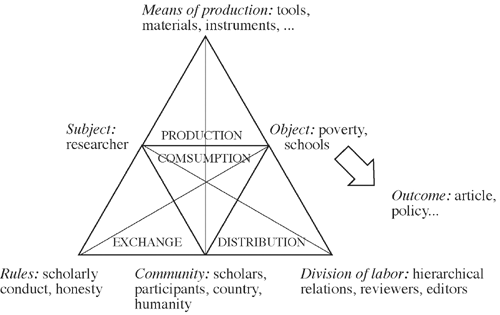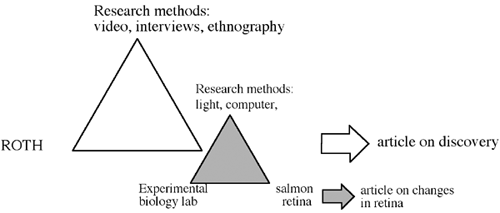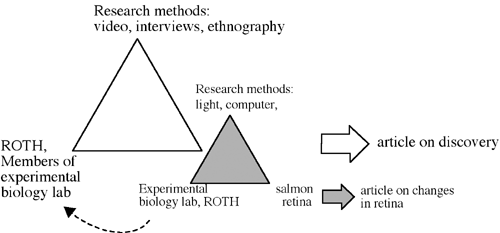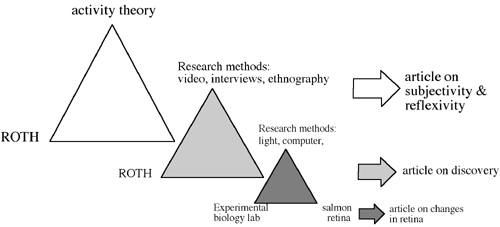

Volume 4, No. 2, Art. 24 – May 2003
Reflexivity and Subjectivity: A Possible Road Map for Reading the Special Issues
Wolff-Michael Roth & Franz Breuer
Abstract: We propose an activity-theoretic framing of research and research object as a road map for reading the articles in the two special issues on the topic of subjectivity and reflexivity. The framework theorizes research as activity, which highlights the constructed nature of research process and research object. The framework therefore brings the reflexive nature of research explicitly into focus. We show how different forms of reflexivity can be theorized with this framework.
Key words: activity theory, reflexivity, methodology, subjectivity
Table of Contents
1. Introduction
2. Activity Theory
3. The Research Process as Form of Activity
3.1 Toward a reflexive social science
3.2 Ethnomethodological reflexivity
3.3 Action research and reflexivity
3.4 Subjectivity and reflexivity
4. Conclusion
Researchers formed in the hermeneutic tradition know that every text lends itself to multiple reading, a situation that is embodied by the nature of the sign (DERRIDA 1988). However, not only the content of reading but also the process may differ from reader to reader. Not every reading process lends itself as a framework for comparatively reading one or two special issues on the same topic. In this section we therefore provide a framework that both topicalizes the reflexive and subjective nature of research and the reading process itself. This introduction therefore constitutes a possible road map for a comparative reading of all articles in the two special issues, including this one that presents a road map. [1]
To conceptualize the research process, including the relation of the researcher as subject and his or her research object, we can use activity theory in which subject and object are already explicitly included in the ontology. Activity theory focuses on practical actions and investigates their mediated nature and embeddedness in systems rather than in the heads of people. Because reflexivity and subjectivity are performed, activity theory is an appropriate way of framing doing research, writing research, and reading research. [2]
Activity theory maintains that cognition, emotion, or motivation cannot be understood outside actual praxis, which is always conceived in terms of activity as a system of relations (LEONT'EV 1978). The main conceptual entities include the subject (individual, group) of the activity, its object, the means of production (tools, instruments), the community in which the subject is part, the division of labor, and the rules or norms of behavior that the community has adopted (ENGESTRÖM 1999). For example, Figure 1 depicts the activity system involving a researcher whose research object is the schooling of children from poverty. This relation between the subject and its object is dialectical, that is, it forms an indivisible unit; furthermore, the object is itself dialectical because of its dual existence as a concrete situation or object and as a vision, idea, or motive.

Figure 1: Depicted is an activity system involving a researcher interested in the effect of poverty on learning and the reproduction
of social inequities. [3]
The relationship between the subject and its object is not direct, however. Rather, it is mediated by the means of production, including tools (e.g., theory), materials, or instruments (camera). The relation is further mediated by the community of which the researcher is a part, which is the source of the motive for the particular activity (researching makes sense in a community of researchers) and which is also the ultimate target or consumer of the products of the activity (producing research articles would be meaningless if there was nobody reading them). In activity theoretic terms, each pair of entities is mediated by other entities. Because of these relations, the outcome of the activity, its product, literally embodies the traces of the activity system as a whole rather than being solely attributable to the solitary researcher and his or her mind. Furthermore, the object cannot be understood independent of the researcher (subject), and therefore is always, and dialectically so, tied up with him/her. [4]
For example, we can think of a researcher conducting interviews with scientists (e.g., RITTENHOFER) then the outcomes, the texts produced by the scientists, cannot be understood outside of the activity system of research. The nature of the relation between what has been said during the researcher's interview and the situation that the interview has been about has to be established empirically and cannot be taken for granted. Whatever the scientists do in their everyday lives is part of one activity system, and the outcome of the interview has to be understood in terms of a very different activity system. Even the particular research questions she asked cannot be understood outside the activity system of which she is a part, including the historical transformations of the system as a whole and each entity including her own biographical experience as a scholar in a foreign land. That is, in activity theory, the basic entities and their mediated relations are not stable but undergo continuous change. To understand an activity system as it is today, we always also have to do a historical analysis that shows how the system came to where it now is. [5]
Another important feature of activity theory are the contradictions that exist and operate in the system (ENGESTRÖM 1987). These contradictions can occur in different places within the system, that is, within one of the entities, in the relation between two entities, between an activity system and a similar but more advanced system, and between different activity systems. Contradictions are not considered as negative aspects a priori, but as the drivers of change characteristic of a dialectical logic. As the contribution by LEE and ROTH shows, contradictions are inherent to the growth not only of knowledge but also of the researchers' identities as well. [6]
3. The Research Process as Form of Activity
3.1 Toward a reflexive social science
This basic framework now allows us to conceptualize the research process, where the object is another activity system. Let us take a look at one of our research projects, in which Wolff-Michael ROTH studies an experimental biology laboratory that investigates the absorption of light in the retina of salmonids (Figure 2). The biology laboratory is the subject in the activity system under study (shaded in grey) and constitutes the object of a second activity system.

Figure 2: The sociological research has as its object an experimental biology laboratory studying salmonid retina. [7]
This figure allows us to thematize an important discussion concerning reflexivity in the domain of social studies of science (ASHMORE 1989; WOOLGAR 1988). Many of those involved in science studies at the time (and others to this date) talk and write about the social construction of knowledge, using the research results on scientific laboratories, such as the case studies conducted by KNORR-CETINA (1981) or LATOUR and WOOLGAR (1986) as evidence. However, these reports were written such as if they constituted the truth about their objects without reflecting the same theoretical and methodological considerations to themselves as activity systems. That is, critics pointed out that there existed a contradiction between the content of reports about scientific discovery work and the way the authors of such reports presented themselves, their claims, and their research processes. That is, in terms of Figure 2, there was a contradiction within the outcome of social science research activity. [8]
The figure also allows us to understand why scientists in particular often resist allowing social science researchers into their laboratories—they feel and really are the objects in another activity system, being in the same place (literally here in these representations) where they know their fish retina to be in their own activity system. That is, the scientists feel that they are objectified in the other activity system, that they are no longer the subjects that they experience themselves to be. Doing (participatory) action research is a frequently used paradigm to escape the unwanted objectification. [9]
3.2 Ethnomethodological reflexivity
Ethnomethodological reflexivity concerns the relation between the methods used by the members of the biology laboratory and those by the researcher. To understand, ethnomethodologists claim, the social science researcher ROTH already has to be competent in the same methods that he makes the topic of his research (e.g., GARFINKEL 1967; GARFINKEL & SACKS 1986). Identifying what is involved in the social phenomenon of queuing, to explain and theorize the phenomenon requires that the researcher already has an understanding of queuing (LIVINGSTON 1987). Some ethnomethodologists therefore use a way of writing their texts such that the readers, once they are through the text, have experienced and developed an understanding of the very phenomenon that the text is about. For example, one text concerning GOETHE's color theory requires readers to use a prism to look at the figures and in their viewing authenticate the very things that the text intends to characterize (BJELIC 1992). [10]
3.3 Action research and reflexivity
If the members of the biology laboratory are interested in conducting research on becoming more effective or to change their ways of doing research in some way, and would ask ROTH for help in doing so, they might engage together in an action research project. That is, in this case, ROTH would become part of the laboratory and the laboratory members' part of the activity system of research reflecting on the activity (Figure 3). The subjects in both activity systems are the same. Such an approach was used both implicitly and meta-theoretically to conceptualize participatory action research on teaching in the highly volatile situation of inner-city schools in Philadelphia, where 90% of the students come from families that live in poverty (ROTH & TOBIN 2002).

Figure 3: As part of a participatory action research project, the social science researcher becomes part of the laboratory;
to improve the work (interaction with hatcheries) of the scientific laboratory, ROTH and the laboratory members reflect on
the activity system. [11]
Being both subject and object of research introduces an interesting phenomenon, the possibility of transformation and learning. Figure 3 shows that the same individuals (subject) produces scientific knowledge about salmon retina and knowledge about scientific discovery processes. This second form of knowledge is of a different logical type (BATESON 1980), it is knowledge about knowledge generation and the process is learning about learning, meta-learning. Because the social science researchers can "change their coats" and return to the scientific laboratory, their newly acquired knowledge about scientific discovery may change the actual processes by means of which the researchers get their work done. Action research and participatory action research inherently carry the potential for development, expansive learning, and transformation because they combine the processes of learning and meta-learning (learning about context) that makes higher forms of organisms possible (BATESON 1980). [12]
3.4 Subjectivity and reflexivity
In the FQS special issues on subjectivity and reflexivity, another level of activity becomes thematic in that social science researchers make their own research activity a topic of reflection. Expanding on the previous examples, the reflection on subjectivity and reflexivity involves another level of activity in which the previous activity systems become the object of reflection (Figure 4). For example, ROTH might reflect on the relation between himself, the subject of the research activity and his object, the experimental biology research; or he may reflect on the relation between himself, the researcher, and the members of the biology laboratory, the subjects of another activity system objectified in his own.

Figure 4: A reflexive conceptualization of the ongoing activity, whereby a social science researcher makes his own research
activity as a whole or in parts the topic of reflection. [13]
When researchers, such as DAY write about the reflexivity in their own research process, another level is involved, where the object already involves ideas about reflexivity that are incorporated into the research project and now described at yet another level. [14]
Some researchers are simply concerned with their own subjectivity, so that their reflections do not get them to a new level, for they do not attempt to understand the mediated nature of activity operating at the different levels, or the mediated nature of the relations. Thus, DAY, for example, reflects on her own subjectivity independent of how her (subject) relations to other entities of the research activity system of which she is part. [15]
In this article, we theorize observed and observer phenomena in terms of activities and actions. This comes with at least two advantages. First, researcher activity is but another form of activity so that the theories used for understanding observed phenomena also account for the research. This framework does not allow researchers to split methodology from epistemology. Second, this framework allows us to theorize different levels of participation in research and research process and therefore build different forms of reflexivity directly into the research process. It also allows us to make thematic the various kinds of reflexivity that have previously been identified (LYNCH 2000). [16]
Using this framework, readers can ask themselves in the context of each study that they read what kind and level of reflexivity the author(s) attempt to achieve, who the subject is, whether the subject is also a member of the group objectified for the purpose of reflection, and so on. The framework is therefore something like a checklist that allows readers to keep track whether an author has indeed included all the mediating entities that constitute the object of inquiry, the (reflexive) inquiry process, and the (reflexive) process of writing itself. In particular, readers may ask whether the structure of the representation is reflexive to the objects, arguments, or processes that the article is about. [17]
Ashmore, Malcolm (1989). The reflexive thesis: Wrighting sociology of scientific knowledge. Chicago: University of Chicago Press.
Bateson, Gregory (1980). Mind and nature: A necessary unity. Toronto: Bantam Books.
Bjelíc, Dusan I. (1992). The praxiological validity of natural scientific practices as a criterion for identifying their unique social-object character: The case of the "authentication" of Goethe's morphological theorem. Qualitative Sociology, 15, 221-245.
Derrida, Jacques (1988). Limited inc. Chicago: University of Chicago Press.
Engeström, Yrjö (1987). Learning by expanding: An activity-theoretical approach to developmental research. Helsinki: Orienta-Konsultit.
Engeström, Yrjö (1999). Activity theory and individual and social transformation. In Yrjö Engeström, Reijo Miettinen, & Raija-Leena Punamäki (Eds.), Perspectives on activity theory (pp.19-38). Cambridge, England: Cambridge University Press.
Garfinkel, Harold (1967). Studies in ethnomethodology. Englewood Cliffs, NJ: Prentice-Hall.
Garfinkel, Harold & Sacks, Harvey (1986). On formal structures of practical action. In Harold Garfinkel (Ed.), Ethnomethodological studies of work (pp.160-193). London: Routledge & Kegan Paul.
Knorr-Cetina, Karin D. (1981). The manufacture of knowledge: An essay on the constructivist and contextual nature of science. Oxford: Pergamon Press.
Latour, Bruno & Woolgar, Steve (1986). Laboratory life: The social construction of scientific facts. Princeton, NJ: Princeton University Press.
Leont'ev, Alexei N. (1978). Activity, consciousness and personality. Englewood Cliffs, CA: Prentice Hall.
Livingston, Eric (1987). Making sense of ethnomethodology. London: Routledge & Kegan Paul.
Lynch, Michael. (2000). Against reflexivity as an academic virtue and source of privileged knowledge. Theory, Culture, & Society, 17, 26-54.
Roth, Wolff-Michael & Tobin, Ken G. (2002). At the elbow of another: Learning to teach by coteaching. New York: Peter Lang.
Woolgar, Steve (1988). Reflexivity is the ethnographer of the text. In Steve Woolgar (Ed.), Knowledge and reflexivity: New frontiers in the sociology of knowledge (pp.14-34). London: Sage Publications.
Wolff-Michael ROTH, Franz BREUER
Roth, Wolff-Michael & Breuer, Franz (2003). Reflexivity and Subjectivity: A Possible Road Map for Reading the Special Issues [17 paragraphs]. Forum Qualitative Sozialforschung / Forum: Qualitative Social Research, 4(2), Art. 24, http://nbn-resolving.de/urn:nbn:de:0114-fqs0302242.